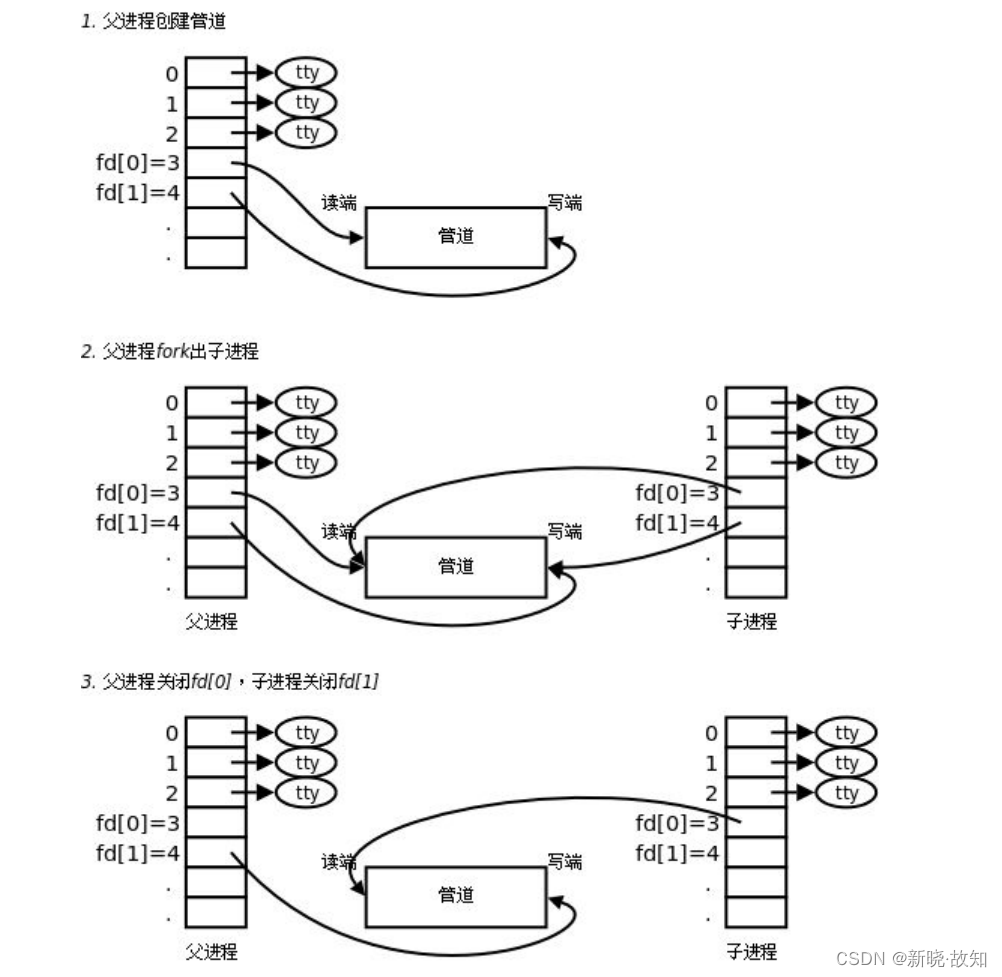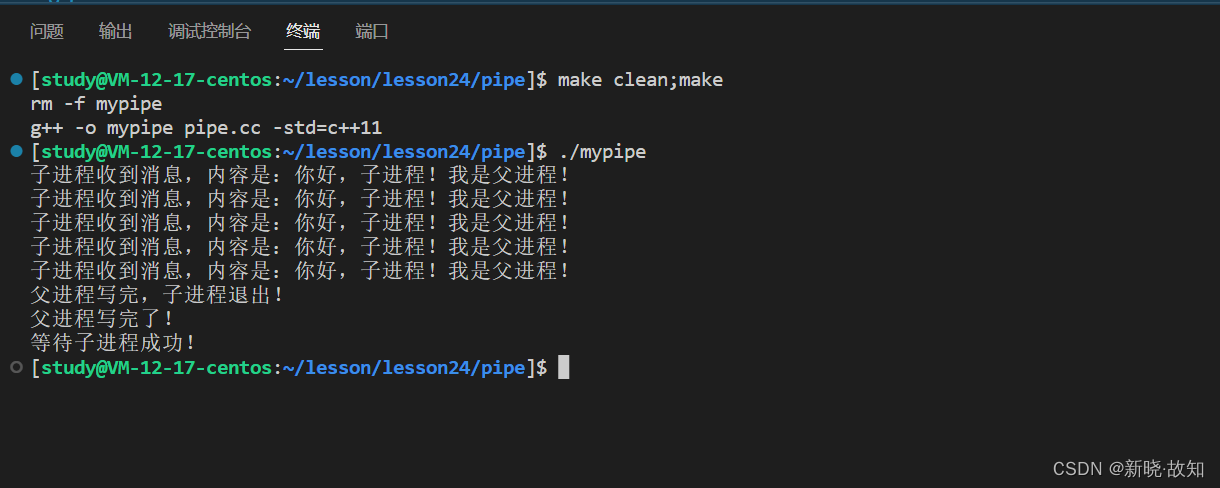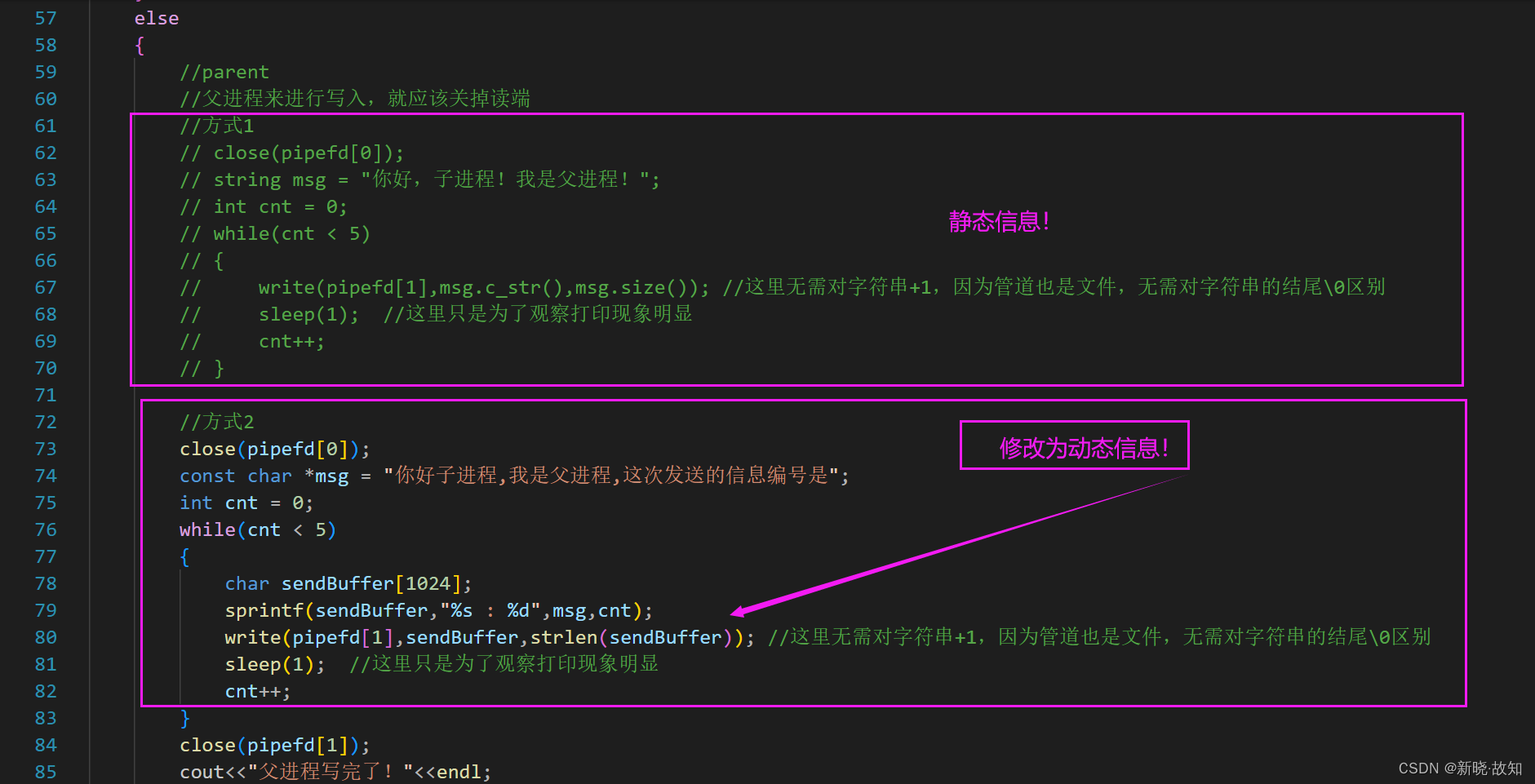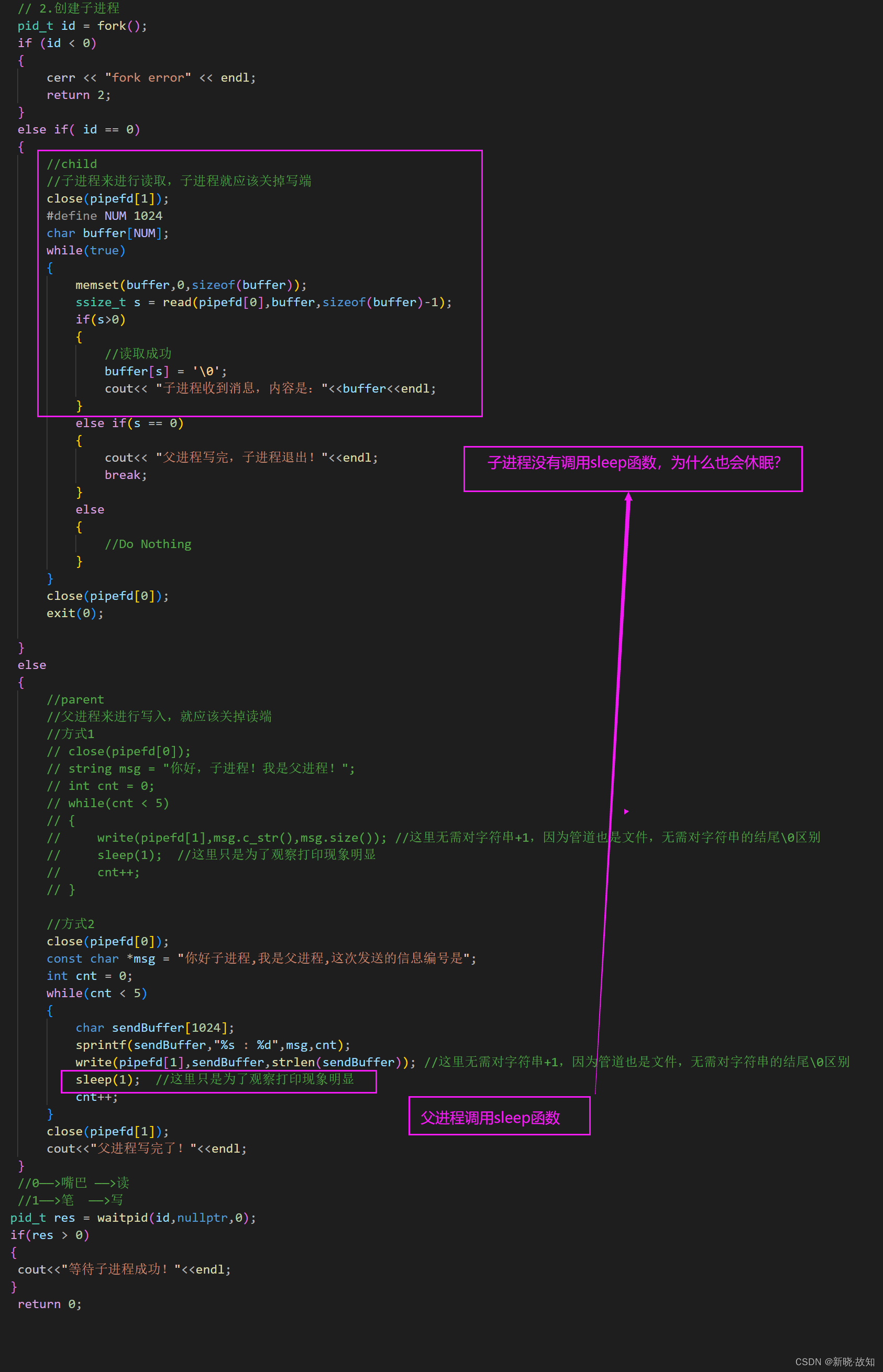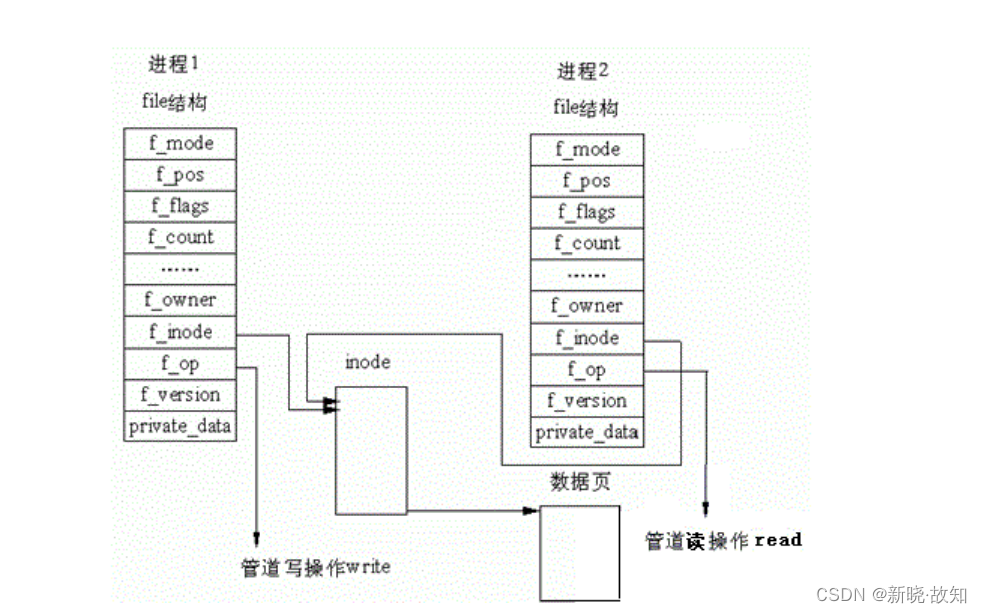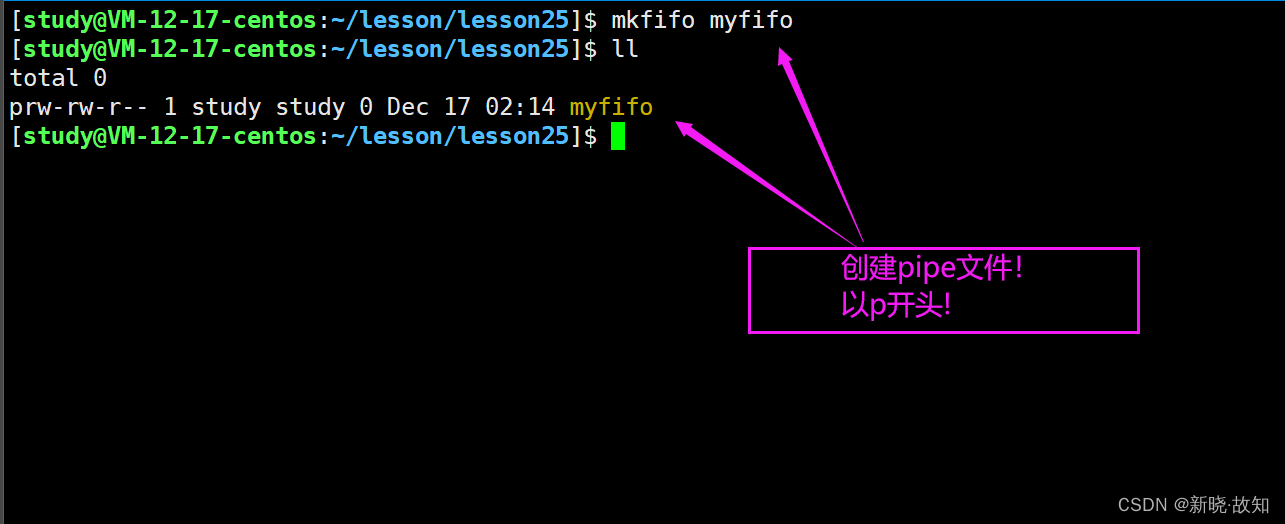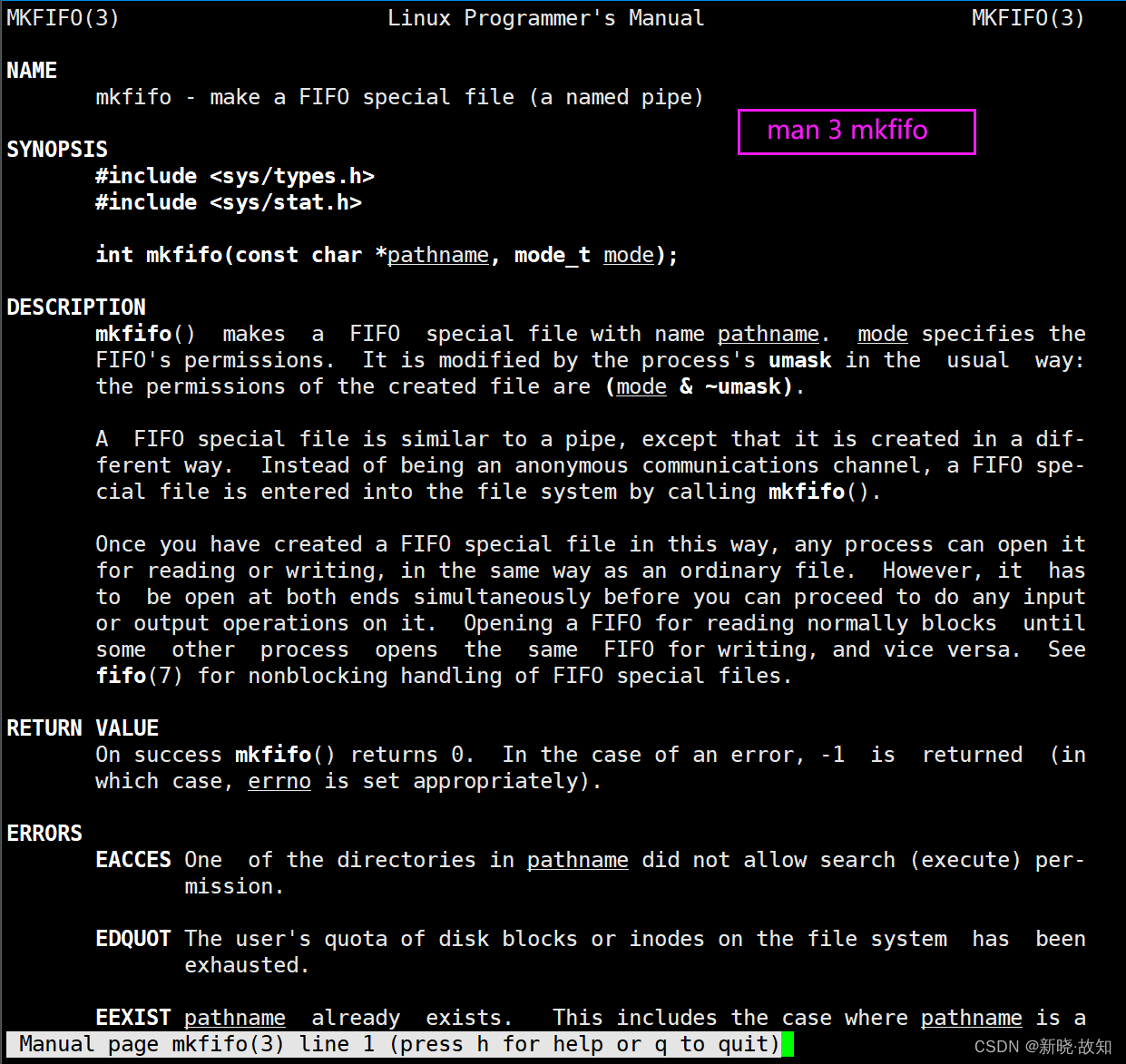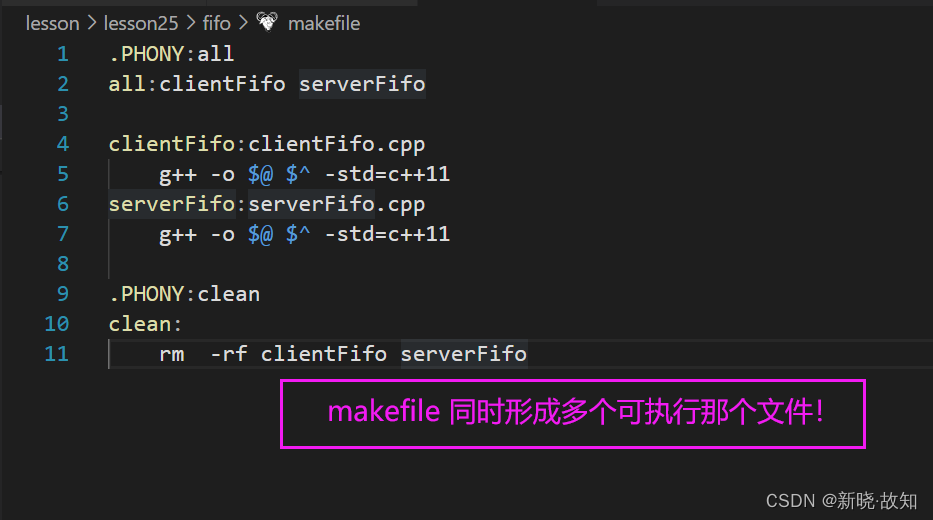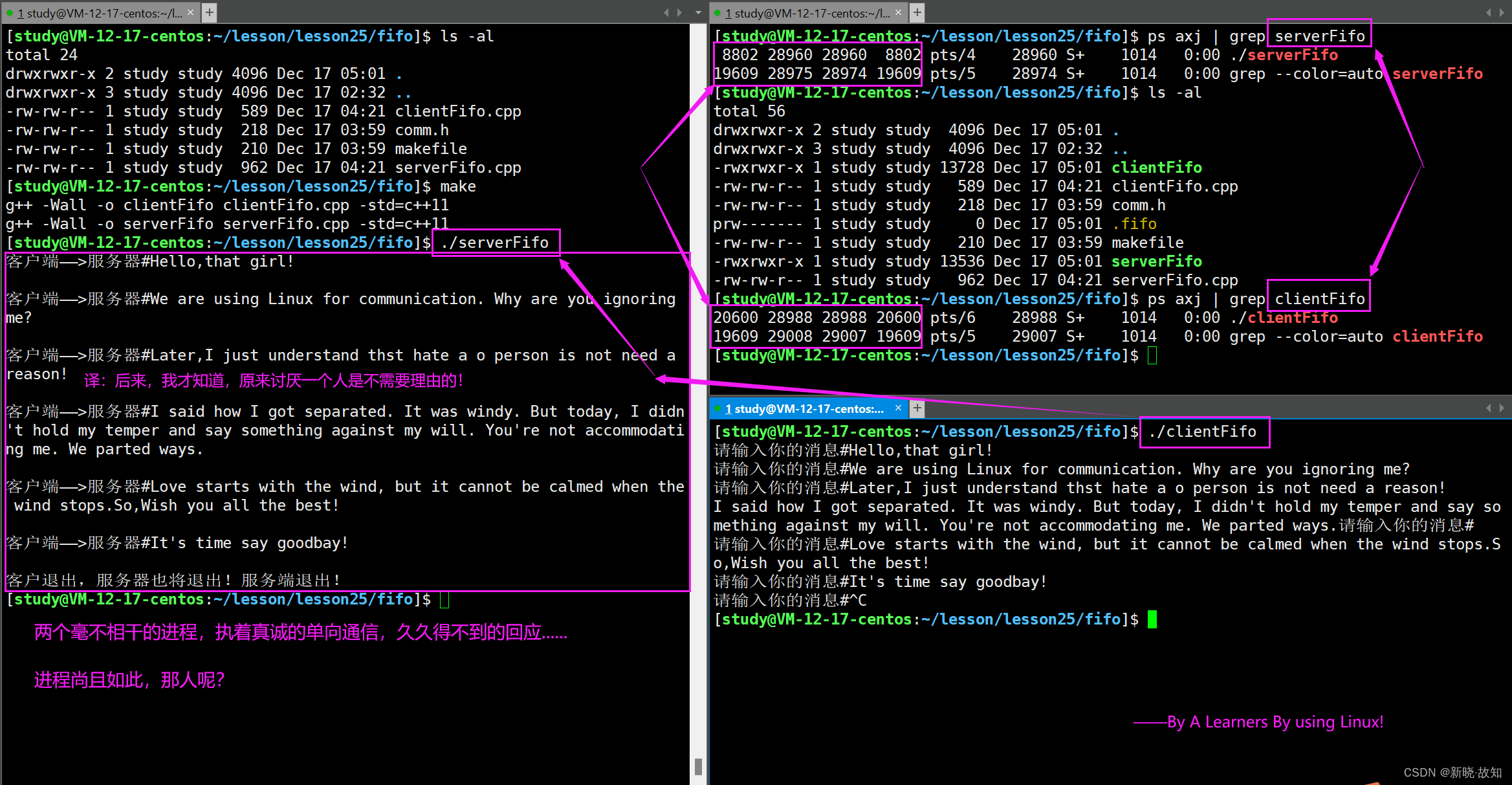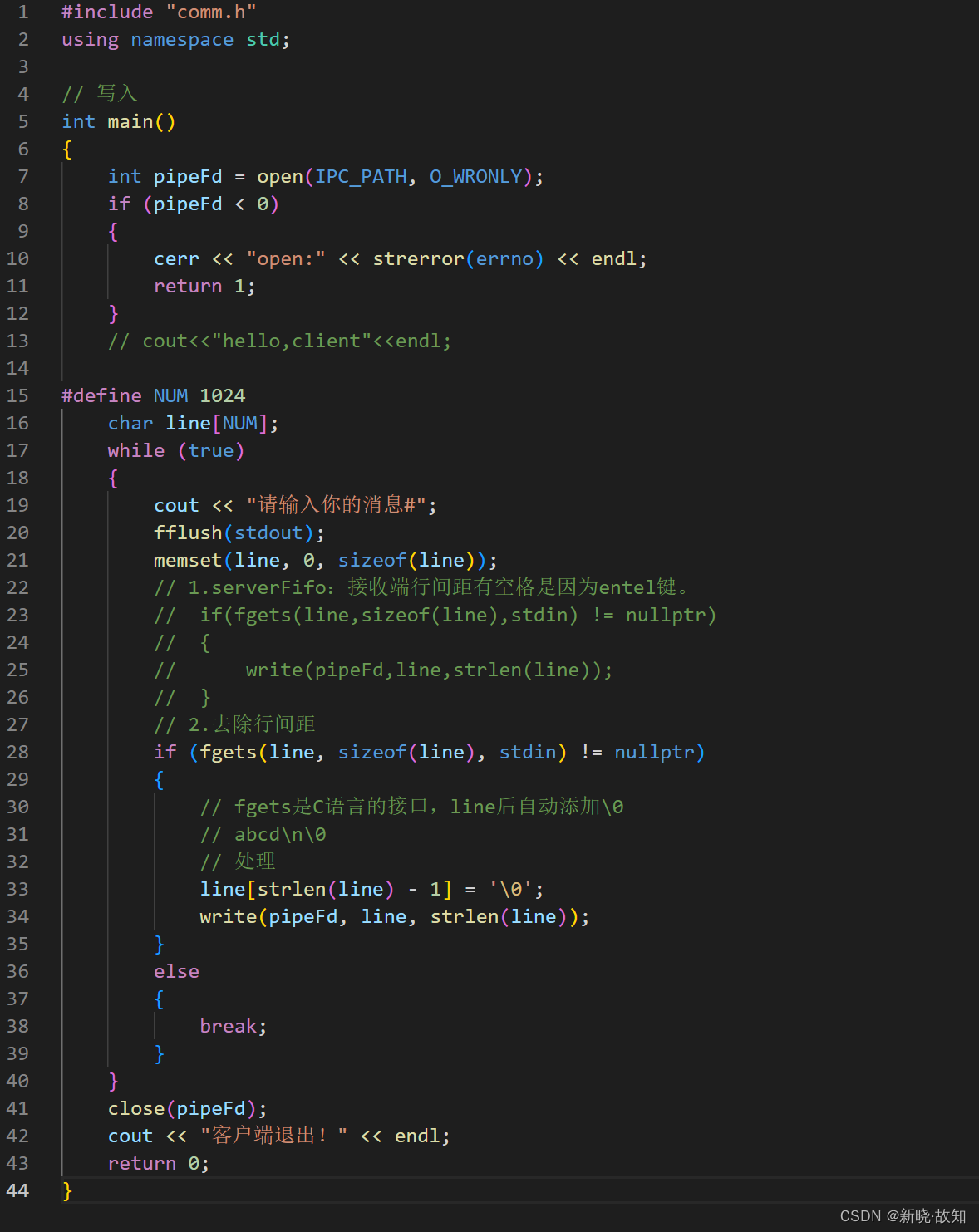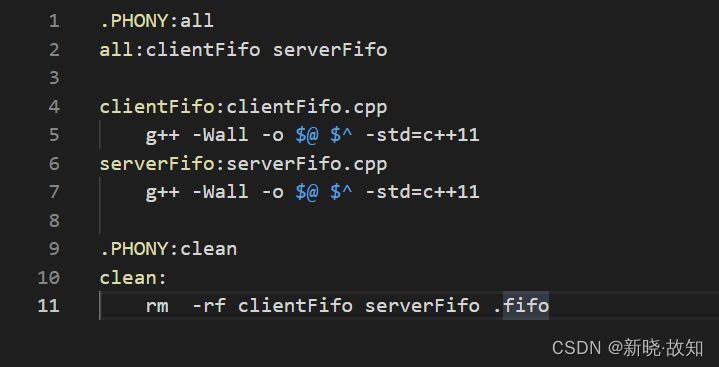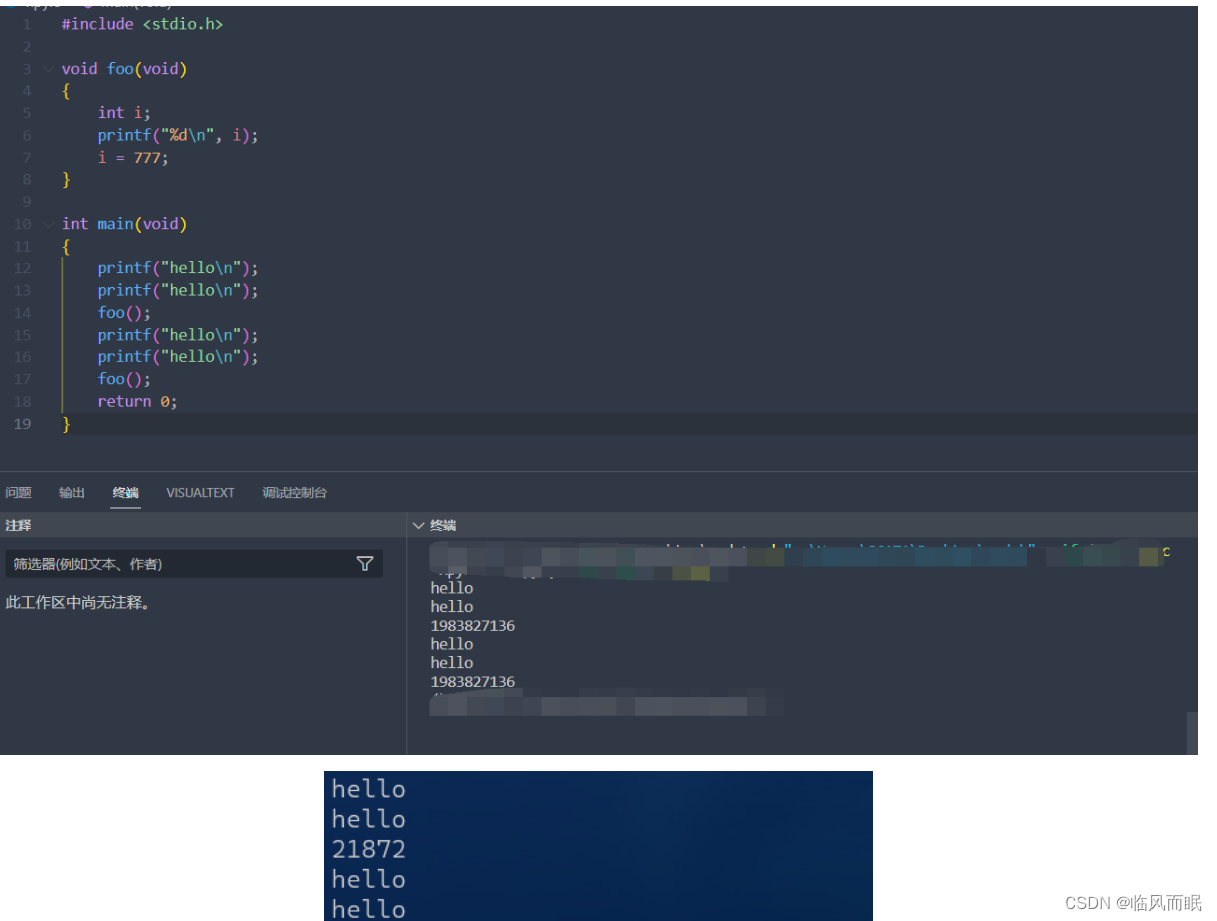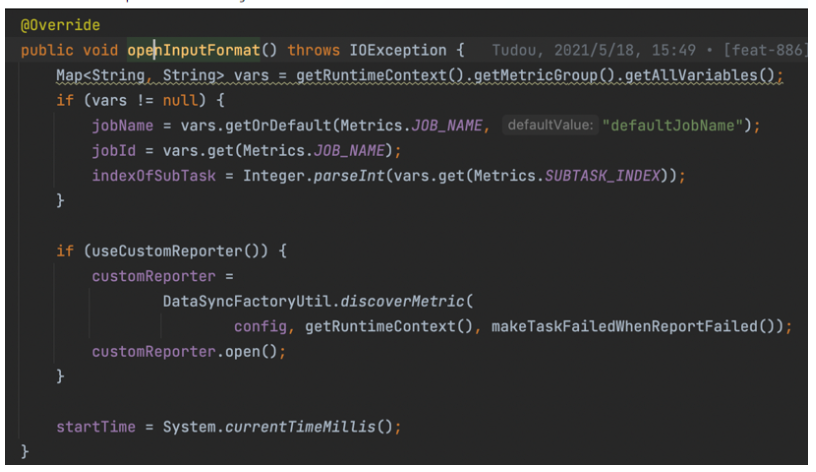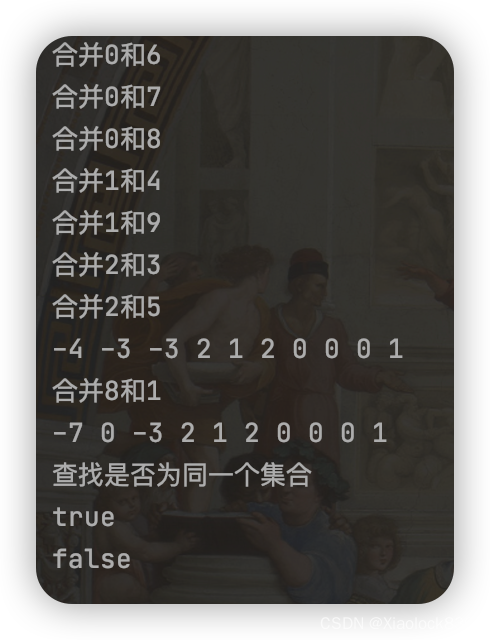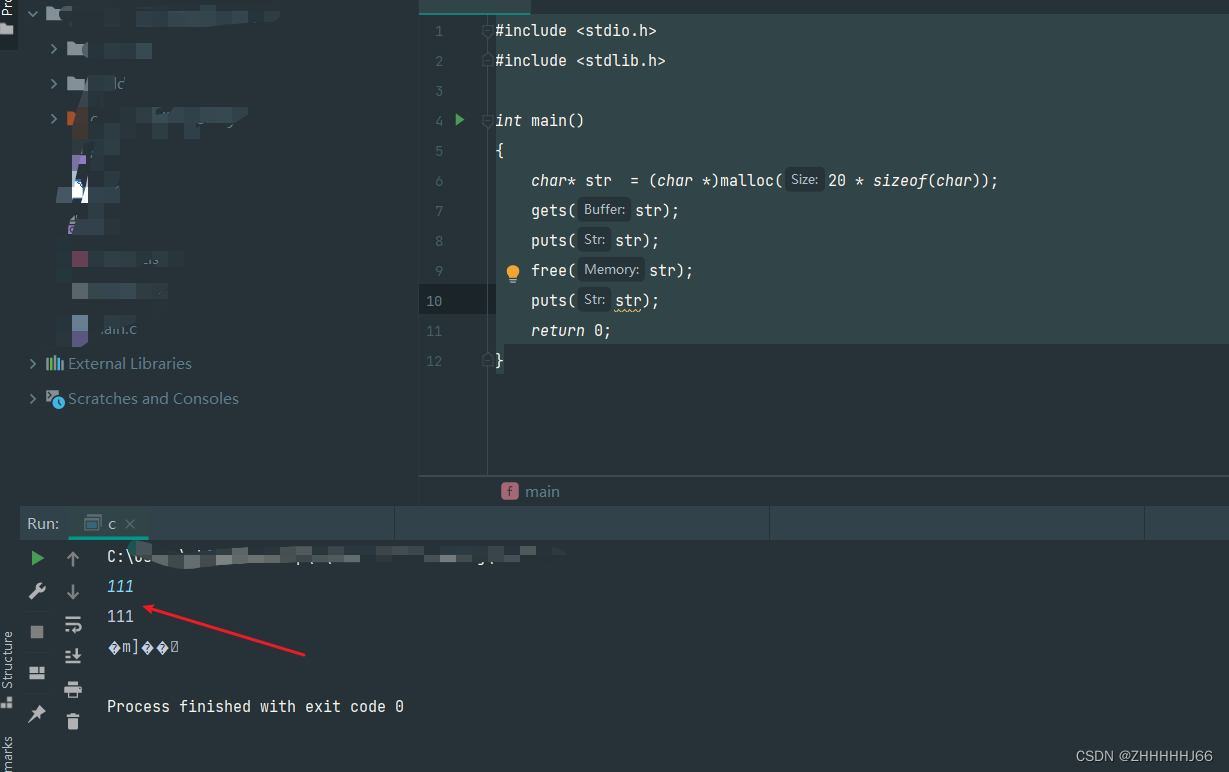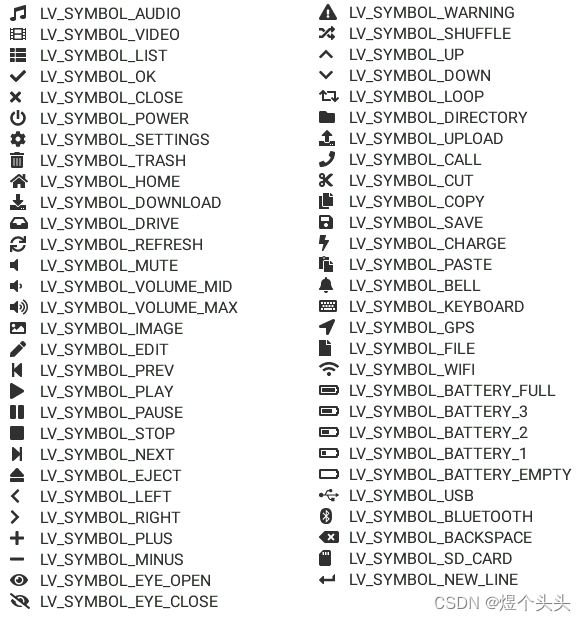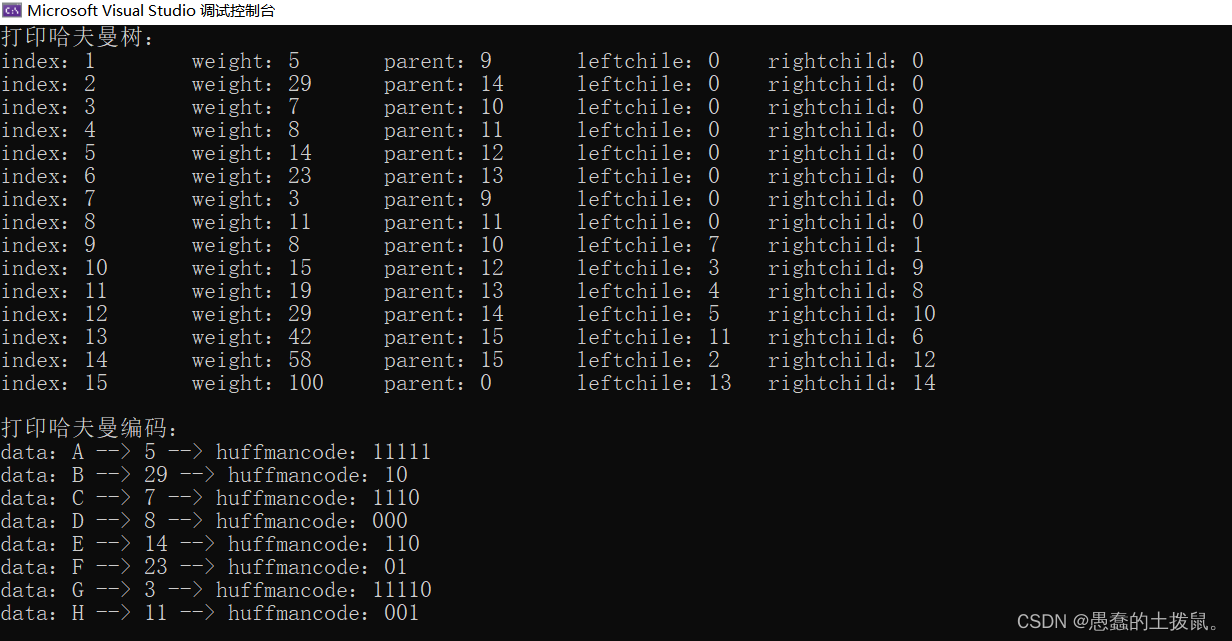目录
一、进程通信
1.进程间通信介绍
2.进程间通信目的
3.进程间通信发展
4.进程间通信分类
二、管道
1.什么是管道
2.匿名管道
3.用fork来共享管道原理
4.站在文件描述符角度-深度理解管道编辑
5.编程模拟实现父子进程在管道读写通信编辑
6.进程控制:
6.1 父进程控制单个子进程
6.2父进程控制批量子进程
6.3初识负载均衡:
7.站在内核角度-管道本质
7.1例:在minishell中添加管道的实现:
8.管道读写规则
9.管道特点
10.管道的特征总结:
11.命名管道
11.1 创建一个命名管道
11.2 匿名管道与命名管道的区别
11.3 命名管道的打开规则
11.4 例:用命名管道实现文件拷贝
11.5 例:用命名管道实现server&client通信(C语言实现)
12. 用命名管道实现server&client通信(C++实现)
13.模拟实现两个互不相干的进程进行通信:
后记:●由于作者水平有限,文章难免存在谬误之处,敬请读者斧正,俚语成篇,恳望指教!
——By 作者:新晓·故知
一、进程通信
1.进程间通信介绍

通信之前,需要让不同的进程(进程具有独立性)看到同一份资源(文件、内存块等)
我们要学的进程间通信,不是告诉我们如何通信,而是两个进程如何先看到同一份资源!
资源的不同,决定了不同种类的通信方式!
2.进程间通信目的
数据传输:一个进程需要将它的数据发送给另一个进程资源共享:多个进程之间共享同样的资源。通知事件:一个进程需要向另一个或一组进程发送消息,通知它(它们)发生了某种事件(如进程终止时要通知父进程)。进程控制:有些进程希望完全控制另一个进程的执行(如 Debug 进程),此时控制进程希望能够拦截另一个进程的所有陷入和异常,并能够及时知道它的状态改变。
3.进程间通信发展
管道System V 进程间通信POSIX 进程间通信
4.进程间通信分类
管道匿名管道 pipe命名管道System V IPCSystem V 消息队列System V 共享内存System V 信号量POSIX IPC消息队列共享内存信号量互斥量条件变量读写锁
二、管道
1.什么是管道
管道是 Unix 中最古老的进程间通信的形式。我们把从一个进程连接到另一个进程的一个数据流称为一个 “管道”管道:提供共享资源的一种手段!
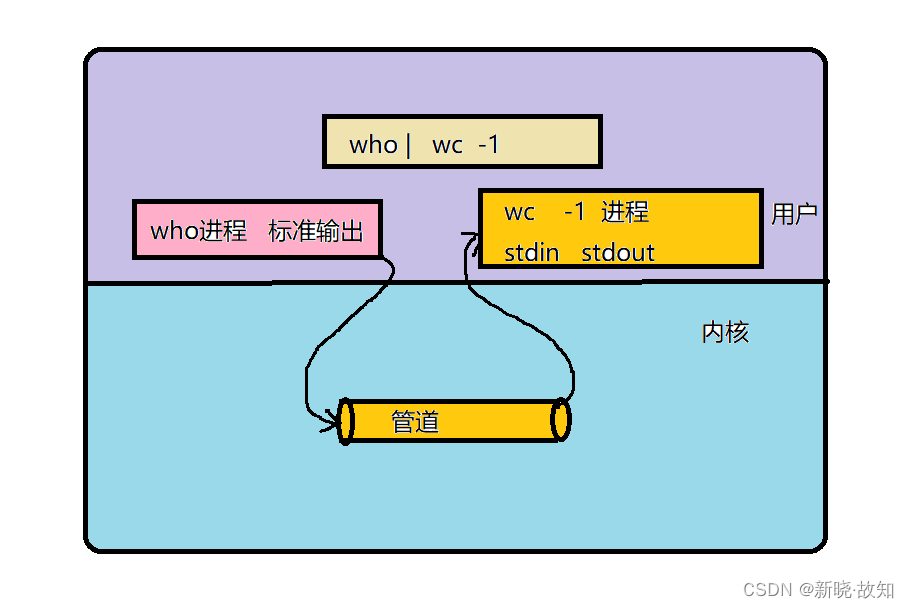
2.匿名管道
#include <unistd.h>功能 : 创建一无名管道原型: int pipe(int fd[2]);参数: fd:文件描述符数组 , 其中 fd[0] 表示读端 , fd[1] 表示写端返回值 : 成功返回 0 ,失败返回错误代码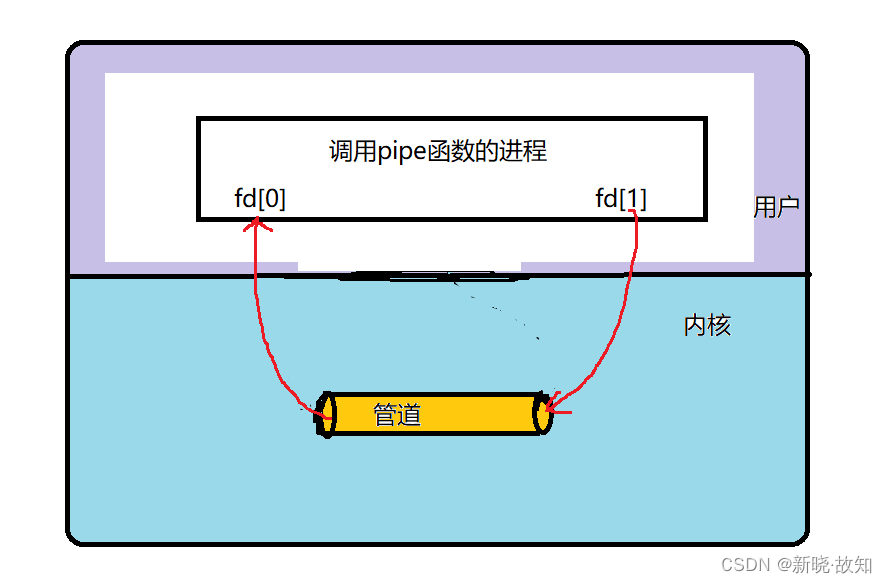
实例代码
例子:从键盘读取数据,写入管道,读取管道,写到屏幕 #include <stdio.h> #include <stdlib.h> #include <string.h> #include <unistd.h> int main( void ) { int fds[2]; char buf[100]; int len; if ( pipe(fds) == -1 ) perror("make pipe"),exit(1); // read from stdin while ( fgets(buf, 100, stdin) ) { len = strlen(buf); // write into pipe if ( write(fds[1], buf, len) != len ) { perror("write to pipe"); break; } memset(buf, 0x00, sizeof(buf)); // read from pipe if ( (len=read(fds[0], buf, 100)) == -1 ) { perror("read from pipe"); break; } // write to stdout if ( write(1, buf, len) != len ) { perror("write to stdout"); break; } } }3.用fork来共享管道原理

4.站在文件描述符角度-深度理解管道
5.编程模拟实现父子进程在管道读写通信
mypipe:pipe.cc g++ -o $@ $^ -std=c++11 .PHONY:clean clean: rm -f mypipe
#include <iostream> #include <cstdio> #include <unistd.h> using namespace std; int main() { int pipefd[2] = {0}; if (pipe(pipefd) != 0) { cerr << "pipe" << endl; return 1; } cout << "fd[0]: "<<pipefd[0]<<endl; cout << "fd[1]: "<<pipefd[1]<<endl; return 0; }模拟父子进程在管道读写通信:
#include <iostream> #include <cstdio> #include <cstring> #include <unistd.h> #include <sys/wait.h> #include <sys/types.h> using namespace std; int main() { //1.创建管道 int pipefd[2] = {0}; if (pipe(pipefd) != 0) { cerr << "pipe" << endl; return 1; } // 2.创建子进程 pid_t id = fork(); if (id < 0) { cerr << "fork error" << endl; return 2; } else if( id == 0) { //child //子进程来进行读取,子进程就应该关掉写端 close(pipefd[1]); #define NUM 1024 char buffer[NUM]; while(true) { memset(buffer,0,sizeof(buffer)); ssize_t s = read(pipefd[0],buffer,sizeof(buffer)-1); if(s>0) { //读取成功 buffer[s] = '\0'; cout<< "子进程收到消息,内容是:"<<buffer<<endl; } else if(s == 0) { cout<< "父进程写完,子进程退出!"<<endl; break; } else { //Do Nothing } } close(pipefd[0]); exit(0); } else { //parent //父进程来进行写入,就应该关掉读端 //方式1 // close(pipefd[0]); // string msg = "你好,子进程!我是父进程!"; // int cnt = 0; // while(cnt < 5) // { // write(pipefd[1],msg.c_str(),msg.size()); //这里无需对字符串+1,因为管道也是文件,无需对字符串的结尾\0区别 // sleep(1); //这里只是为了观察打印现象明显 // cnt++; // } //方式2 close(pipefd[0]); const char *msg = "你好子进程,我是父进程,这次发送的信息编号是"; int cnt = 0; while(cnt < 5) { char sendBuffer[1024]; sprintf(sendBuffer,"%s : %d",msg,cnt); write(pipefd[1],sendBuffer,strlen(sendBuffer)); //这里无需对字符串+1,因为管道也是文件,无需对字符串的结尾\0区别 sleep(1); //这里只是为了观察打印现象明显 cnt++; } close(pipefd[1]); cout<<"父进程写完了!"<<endl; } //0——>嘴巴 ——>读 //1——>笔 ——>写 pid_t res = waitpid(id,nullptr,0); if(res > 0) { cout<<"等待子进程成功!"<<endl; } return 0; }
(1)当父进程没有写入数据的时候,子进程在等!所以,父进程写入之后,子进程才能read(会返回) 到数据,子进程打印读取数据要以父进程的节奏为主!
(2)父进程和子进程读写的时候,是有一定的顺序性的!
在管道这里,管道是可以被写满的。查看管道信息指令:ulimit -a
管道内部,如果没有数据,reader就必须阻塞等待(read),等管道有数据。
管道内部,如果数据被写满,writer就必须阻塞等待(write),等待管道中有空间。
以上,具有顺序性是因为pipe内部自带访问控制机制!(同步和互斥机制)
(3)我们之前所学的父、子进程各自printf(向显示器写入,显示器也是文件)的时候,会有顺序吗?
没有。这个没有访问控制机制!
(4)阻塞等待的本质:
将当前进程的task_struct放入等待队列中!
6.进程控制:
控制进程根据需求做出响应。
6.1 父进程控制单个子进程
#include <iostream> #include <cstdio> #include <cstring> #include <ctime> #include <vector> #include <cstdlib> #include <cassert> #include <unordered_map> #include <unistd.h> #include <sys/wait.h> #include <sys/types.h> using namespace std; typedef void (*functor)(); // 函数指针 vector<functor> functors; // 方法集合 // for debug unordered_map<uint32_t, string> info; void f1() { cout << "这是一个处理日志的任务,执行的进程 ID [" << getpid() << "]" << "执行时间是[" << time(nullptr) << "]" << endl; } void f2() { cout << "这是一个备份任务,执行的进程 ID [" << getpid() << "]" << "执行时间是[" << time(nullptr) << "]" << endl; } void f3() { cout << "这是一个处理网络连接的任务,执行的进程 ID [" << getpid() << "]" << "执行时间是[" << time(nullptr) << "]" << endl; } void loadFunctor() { info.insert({functors.size(), "处理日志的任务"}); functors.push_back(f1); info.insert({functors.size(), "备份数据任务"}); functors.push_back(f2); info.insert({functors.size(), "处理网络连接的任务"}); functors.push_back(f3); } int main() { // 0.加载任务列表 loadFunctor(); // 1.创建管道 int pipefd[2] = {0}; if (pipe(pipefd) != 0) { cerr << "pipe error" << endl; return 1; } // 2.创建子进程 pid_t id = fork(); if (id < 0) { cerr << "fork error" << endl; return 2; } else if (id == 0) { // 3.关闭不需要的文件fd // child,read close(pipefd[1]); // 4.业务处理 while (true) { uint32_t operatorType = 0; // 如果有数据就读取。如果没有数据,就阻塞等待,等待任务的到来 ssize_t s = read(pipefd[0], &operatorType, sizeof(uint32_t)); if(s == 0) { cout<<"需求已完成,我即将退出服务状态!"<<endl; break; } assert(s == sizeof(uint32_t)); (void)s; // assert断言,是编译有效debug模式。release模式,断言就没有了。 // 一旦断言没有了,s变量就是只被定义了,没有被使用。release模式中,可能会有warning if (operatorType < functors.size()) { functors[operatorType](); } else { cerr << "bug? operatorType = " << operatorType << endl; } } close(pipefd[0]); exit(0); } else { srand((long long)time(nullptr)); // parent,write-操作 // 关闭不需要的文件fd close(pipefd[0]); // 指派任务 int num = functors.size(); int cnt = 10; // 设定10个任务 while (cnt--) { // 形成任务码 uint32_t commandCode = rand() % num; cout << "父进程指派任务完成,任务是:" << info[commandCode] << "任务的编号是:" << cnt << endl; // 向指定的进程下达执行任务的操作 write(pipefd[1], &commandCode, sizeof(uint32_t)); sleep(1); } close(pipefd[1]); pid_t res = waitpid(id, nullptr, 0); if (res) { cout << "Wait Success!" << endl; } } return 0; }
6.2父进程控制批量子进程
进程如何控制批量进程呢?
这里进程池机制。那么将给哪一个进程指派?给它指派什么任务呢?通过什么指派呢?(通过管道指派)
shell脚本指令:
while :; do ps axj | head -1; ps ajx |grep mypipe | grep -v grep; sleep 1; done6.3初识负载均衡:
#include <iostream> #include <cstdio> #include <cstring> #include <ctime> #include <vector> #include <cstdlib> #include <cassert> #include <unordered_map> #include <unistd.h> #include <sys/wait.h> #include <sys/types.h> using namespace std; typedef void (*functor)(); // 函数指针 vector<functor> functors; // 方法集合 // for debug unordered_map<uint32_t, string> info; void f1() { cout << "这是一个处理日志的任务,执行的进程 ID [" << getpid() << "]" << "执行时间是[" << time(nullptr) << "]\n" << endl; } void f2() { cout << "这是一个备份任务,执行的进程 ID [" << getpid() << "]" << "执行时间是[" << time(nullptr) << "]\n" << endl; } void f3() { cout << "这是一个处理网络连接的任务,执行的进程 ID [" << getpid() << "]" << "执行时间是[" << time(nullptr) << "]\n" << endl; } void loadFunctor() { info.insert({functors.size(), "处理日志的任务"}); functors.push_back(f1); info.insert({functors.size(), "备份数据任务"}); functors.push_back(f2); info.insert({functors.size(), "处理网络连接的任务"}); functors.push_back(f3); } typedef pair<int32_t,int32_t> elem; //第一个int32_t:进程pid,第二个int32_t:该进程对应的管道写端fd vector<elem> assignMap; int processNum = 5; void work(int blockFd) { cout << "进程[" << getpid() << "]" << "开始工作" << endl; // 子进程核心工作的代码 while (true) { // a.阻塞等待 b.获取任务 uint32_t operatorCode = 0; ssize_t s = read(blockFd, &operatorCode, sizeof(uint32_t)); if (s == 0) break; assert(s == sizeof(uint32_t)); (void)s; // c.处理任务 if (operatorCode < functors.size()) functors[operatorCode](); } cout<<"进程["<<getpid()<<"]"<<"结束工作"<<endl; } //[子进程的pid,子进程的管道fd] void balancesendTask(const vector<elem> &processFds) { srand((long long)time(nullptr)); while(true) { sleep(1); //选择一个进程,选择进程是随机的,没有压着一个进程给任务 //较为均匀的将任务给所有的子进程——负载均衡 uint32_t pick = rand()% processFds.size(); //选择一个任务 uint32_t task = rand()%functors.size(); //把任务给一个指定的进程 write(processFds[pick].second,&task,sizeof(task)); //打印对应的提示信息 cout << "父进程指派任务——>" << info[task] << "给进程:" << processFds[pick].first << "编号:" << pick << endl; } } int main() { loadFunctor(); vector<elem> assignMap; // 创建processNum个进程 for(int i =0; i< processNum;i++) { //定义保存管道上fd的对象 int pipefd[2] = {0}; //创建管道 pipe(pipefd); //创建子进程 pid_t id = fork(); if( id == 0) { //子进程读取 close(pipefd[1]); //子进程执行 work(pipefd[0]); close(pipefd[0]); exit(0); } // 父进程做的事情 close(pipefd[0]); elem e(id, pipefd[1]); assignMap.push_back(e); } cout<<"Create All Process Success!"<<endl; //父进程,派发任务 balancesendTask(assignMap); //回收资源 for (int i = 0; i < processNum; i++) { if (waitpid(assignMap[i].first, nullptr, 0) > 0) { cout << "Wait for: pid=" << assignMap[i].first << "Wait Success!" << "number:" << i << endl; } } }7.站在内核角度-管道本质
所以,看待管道,就如同看待文件一样!管道的使用和文件一致,迎合了“Linux一切皆文件思想”。
#include <unistd.h> #include <stdlib.h> #include <stdio.h> #include <errno.h> #include <string.h> #define ERR_EXIT(m) \ do \ { \ perror(m); \ exit(EXIT_FAILURE); \ } while(0) int main(int argc, char *argv[]) { int pipefd[2]; if (pipe(pipefd) == -1) ERR_EXIT("pipe error"); pid_t pid; pid = fork(); if (pid == -1) ERR_EXIT("fork error"); if (pid == 0) { close(pipefd[0]); write(pipefd[1], "hello", 5); close(pipefd[1]); exit(EXIT_SUCCESS); } close(pipefd[1]); char buf[10] = {0}; read(pipefd[0], buf, 10); printf("buf=%s\n", buf); return 0; }7.1例:在minishell中添加管道的实现:
# include <stdio.h> # include <stdlib.h> # include <unistd.h> # include <string.h> # include <fcntl.h> # define MAX_CMD 1024 char command[MAX_CMD]; int do_face() { memset(command, 0x00, MAX_CMD); printf("minishell$ "); fflush(stdout); if (scanf("%[^\n]%*c", command) == 0) { getchar(); return -1; } return 0; } char **do_parse(char *buff) { int argc = 0; static char *argv[32]; char *ptr = buff; while(*ptr != '\0') { if (!isspace(*ptr)) { argv[argc++] = ptr; while((!isspace(*ptr)) && (*ptr) != '\0') { ptr++; } continue; } *ptr = '\0'; ptr++; } argv[argc] = NULL; return argv; } int do_redirect(char *buff) { char *ptr = buff, *file = NULL; int type = 0, fd, redirect_type = -1; while(*ptr != '\0') { if (*ptr == '>') { *ptr++ = '\0'; redirect_type++; if (*ptr == '>') { *ptr++ = '\0'; redirect_type++; } while(isspace(*ptr)) { ptr++; } file = ptr; while((!isspace(*ptr)) && *ptr != '\0') { ptr++; } *ptr = '\0'; if (redirect_type == 0) { fd = open(file, O_CREAT|O_TRUNC|O_WRONLY, 0664); }else { fd = open(file, O_CREAT|O_APPEND|O_WRONLY, 0664); } dup2(fd, 1); } ptr++; } return 0; } int do_command(char *buff) { int pipe_num = 0, i; char *ptr = buff; int pipefd[32][2] = {{-1}}; int pid = -1; pipe_command[pipe_num] = ptr; while(*ptr != '\0') { if (*ptr == '|') { pipe_num++; *ptr++ = '\0'; pipe_command[pipe_num] = ptr; continue; } ptr++; } pipe_command[pipe_num + 1] = NULL; return pipe_num; } int do_pipe(int pipe_num) { int pid = 0, i; int pipefd[10][2] = {{0}}; char **argv = {NULL}; for (i = 0; i <= pipe_num; i++) { pipe(pipefd[i]); } for (i = 0; i <= pipe_num; i++) { pid = fork(); if (pid == 0) { do_redirect(pipe_command[i]); argv = do_parse(pipe_command[i]); if (i != 0) { close(pipefd[i][1]); dup2(pipefd[i][0], 0); } if (i != pipe_num) { close(pipefd[i + 1][0]); dup2(pipefd[i + 1][1], 1); } execvp(argv[0], argv); }else { close(pipefd[i][0]); close(pipefd[i][1]); waitpid(pid, NULL, 0); } } return 0; } int main(int argc, char *argv[]) { int num = 0; while(1) { if (do_face() < 0) continue; num = do_command(command); do_pipe(num); } return 0; }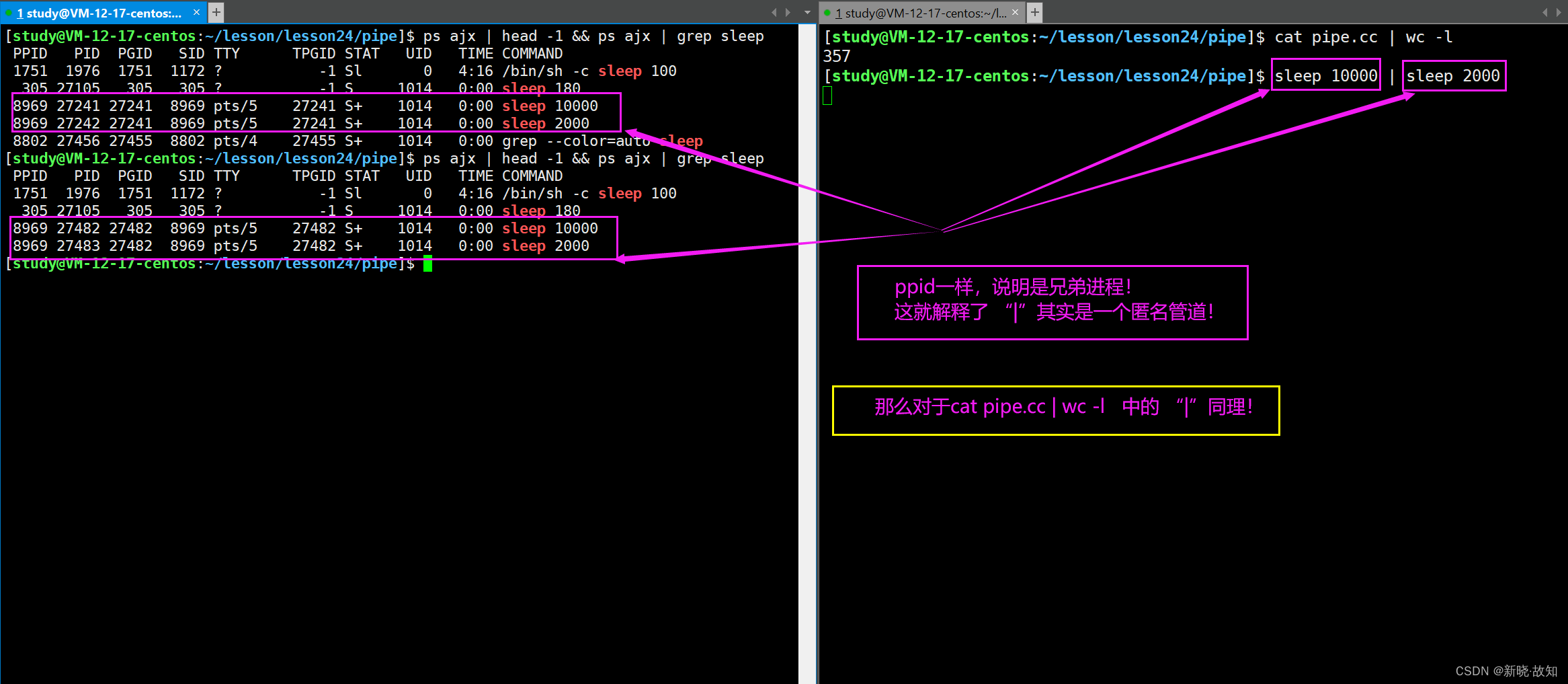
shell脚本:
ps ajx | head -1 && ps ajx | grep sleep
总结:
所谓的命令行中的“|”就是匿名管道!
8.管道读写规则
当没有数据可读时
- O_NONBLOCK disable:read调用阻塞,即进程暂停执行,一直等到有数据来到为止。
- O_NONBLOCK enable:read调用返回-1,errno值为EAGAIN。
当管道满的时候
- O_NONBLOCK disable: write调用阻塞,直到有进程读走数据
- O_NONBLOCK enable:调用返回-1,errno值为EAGAIN
- 如果所有管道写端对应的文件描述符被关闭,则read返回0
- 如果所有管道读端对应的文件描述符被关闭,则write操作会产生信号SIGPIPE,进而可能导致write进程退出
- 当要写入的数据量不大于PIPE_BUF时,linux将保证写入的原子性。
- 当要写入的数据量大于PIPE_BUF时,linux将不再保证写入的原子性。
9.管道特点
只能用于具有共同祖先的进程(具有亲缘关系的进程)之间进行通信;通常,一个管道由一个进程创建,然后该进程调用fork,此后父、子进程之间就可应用该管道。管道提供流式服务
- 一般而言,进程退出,管道释放,所以管道的生命周期随进程
- 一般而言,内核会对管道操作进行同步与互斥
管道是半双工的,数据只能向一个方向流动;需要双方通信时,需要建立起两个管道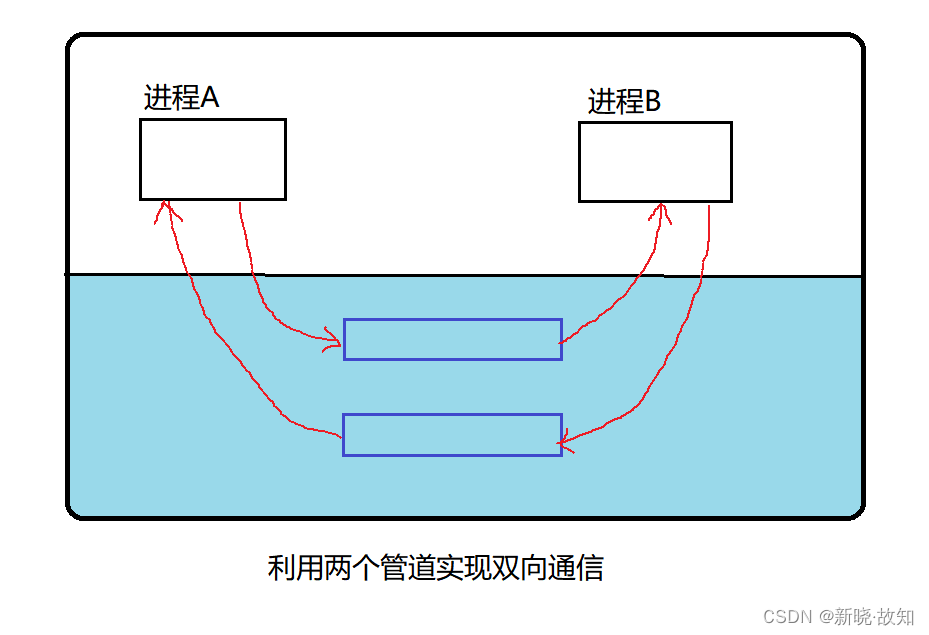
10.管道的特征总结:
1.管道只能用来进行具有血缘关系的进程之间,进行进程间通信,常用于父子进程通信。
2.管道只能单向通信(内核实现决定的)(是半双工的一种特殊情况)。
3.管道自带同步机制(pipe满,writer等待。pipe空,reader等待) ——自带访问控制。
4.管道是面向字节流的。先写的字符,一定是先被读取,没有格式边界,需要用户自己来定义区分内容的边界,例如:[sizeof(uint32_t)]等。这里牵涉到网络TCP协议等知识。
5.管道的生命周期跟随进程:管道是文件,进程退出后,曾经打开的文件也会退出。
那么只能父子进程(或血缘)进程之间通信吗?毫不相干的进程进行通信可以吗?
答:可以。使用命名管道。
11.命名管道
管道应用的一个限制就是只能在具有共同祖先(具有亲缘关系)的进程间通信。如果我们想在不相关的进程之间交换数据,可以使用 FIFO 文件来做这项工作,它经常被称为命名管道。命名管道是一种特殊类型的文件11.1 创建一个命名管道
命名管道可以从命令行上创建,命令行方法是使用下面这个命令:命名管道也可以从程序里创建,相关函数有:创建命名管道 :$ mkfifo filenameint mkfifo(const char *filename,mode_t mode);int main(int argc, char *argv[]) { mkfifo("p2", 0644); return 0; }11.2 匿名管道与命名管道的区别
匿名管道由 pipe 函数创建并打开。命名管道由 mkfififo 函数创建,打开用 openFIFO (命名管道)与 pipe (匿名管道)之间唯一的区别在它们创建与打开的方式不同,一但这些工作完成之后,它们具有相同的语义。11.3 命名管道的打开规则
如果当前打开操作是为读而打开FIFO时
- O_NONBLOCK disable:阻塞直到有相应进程为写而打开该FIFO
- O_NONBLOCK enable:立刻返回成功
如果当前打开操作是为写而打开FIFO时
- O_NONBLOCK disable:阻塞直到有相应进程为读而打开该FIFO
- O_NONBLOCK enable:立刻返回失败,错误码为ENXIO
11.4 例:用命名管道实现文件拷贝
读取文件,写入命名管道 :#include <unistd.h> #include <stdlib.h> #include <stdio.h> #include <errno.h> #include <string.h> #define ERR_EXIT(m) \ do \ { \ perror(m); \ exit(EXIT_FAILURE); \ } while(0) int main(int argc, char *argv[]) { mkfifo("tp", 0644); int infd; infd = open("abc", O_RDONLY); if (infd == -1) ERR_EXIT("open"); int outfd; outfd = open("tp", O_WRONLY); if (outfd == -1) ERR_EXIT("open"); char buf[1024]; int n; while ((n=read(infd, buf, 1024))>0) { write(outfd, buf, n); } close(infd); close(outfd); return 0; }读取管道,写入目标文件 :#include <unistd.h> #include <stdlib.h> #include <stdio.h> #include <errno.h> #include <string.h> #define ERR_EXIT(m) \ do \ { \ perror(m); \ exit(EXIT_FAILURE); \ } while(0) int main(int argc, char *argv[]) { int outfd; outfd = open("abc.bak", O_WRONLY | O_CREAT | O_TRUNC, 0644); if (outfd == -1) ERR_EXIT("open"); int infd; infd = open("tp", O_RDONLY); if (outfd == -1) ERR_EXIT("open"); char buf[1024]; int n; while ((n=read(infd, buf, 1024))>0) { write(outfd, buf, n); } close(infd); close(outfd); unlink("tp"); return 0; }11.5 例:用命名管道实现server&client通信(C语言实现)
# ll total 12 -rw-r--r--. 1 root root 46 Sep 18 22:37 clientPipe.c -rw-r--r--. 1 root root 164 Sep 18 22:37 Makefile -rw-r--r--. 1 root root 46 Sep 18 22:38 serverPipe.c # cat Makefile .PHONY:all all:clientPipe serverPipe clientPipe:clientPipe.c gcc -o $@ $^ serverPipe:serverPipe.c gcc -o $@ $^ .PHONY:clean clean: rm -f clientPipe serverPipeserverPipe.c#include <stdio.h> #include <sys/types.h> #include <sys/stat.h> #include <fcntl.h> #include <unistd.h> #include <stdlib.h> #define ERR_EXIT(m) \ do{\ perror(m);\ exit(EXIT_FAILURE);\ }while(0) int main() { umask(0); if(mkfifo("mypipe", 0644) < 0){ ERR_EXIT("mkfifo"); } int rfd = open("mypipe", O_RDONLY); if(rfd < 0){ ERR_EXIT("open"); } char buf[1024]; while(1){ buf[0] = 0; printf("Please wait...\n"); ssize_t s = read(rfd, buf, sizeof(buf)-1); if(s > 0 ){ buf[s-1] = 0; printf("client say# %s\n", buf); }else if(s == 0){ printf("client quit, exit now!\n"); exit(EXIT_SUCCESS); }else{ ERR_EXIT("read"); } } close(rfd); return 0; }clientPipe.c#include <stdio.h> #include <sys/types.h> #include <sys/stat.h> #include <fcntl.h> #include <unistd.h> #include <stdlib.h> #include <string.h> #define ERR_EXIT(m) \ do{\ perror(m);\ exit(EXIT_FAILURE);\ }while(0) int main() { int wfd = open("mypipe", O_WRONLY); if(wfd < 0){ ERR_EXIT("open"); } char buf[1024]; while(1){ buf[0] = 0; printf("Please Enter# "); fflush(stdout); ssize_t s = read(0, buf, sizeof(buf)-1); if(s > 0 ){ buf[s] = 0; write(wfd, buf, strlen(buf)); }else if(s <= 0){ ERR_EXIT("read"); } } close(wfd); return 0; }结果 :
12. 用命名管道实现server&client通信(C++实现)


在之前我们学习过,两个在内存中的进程在磁盘打开同一文件的情况。这其实就是命名管道的运用。
我们知道,进程间通信的本质是:不同的进程要看到同一份资源。
匿名管道:子进程继承父进程,找到同一个资源!
命名管道:通过一个fifo 文件—>有路径—>具有唯一性—>通过路径找到同一个资源!
13.模拟实现两个互不相干的进程进行通信:
Makefile:
.PHONY:all all:clientFifo serverFifo clientFifo:clientFifo.cpp g++ -o $@ $^ -std=c++11 serverFifo:serverFifo.cpp g++ -o $@ $^ -std=c++11 .PHONY:clean clean: rm -rf clientFifo serverFifo
serverFifo:接收端行间距有空格是因为entel键。
comm.h:
#pragma once #include <iostream> #include <string> #include <cstring> #include <cerrno> #include <cstdio> #include <sys/types.h> #include <sys/stat.h> #include <fcntl.h> #include <unistd.h> #define IPC_PATH "./.fifo"makefile:
.PHONY:all all:clientFifo serverFifo clientFifo:clientFifo.cpp g++ -Wall -o $@ $^ -std=c++11 serverFifo:serverFifo.cpp g++ -Wall -o $@ $^ -std=c++11 .PHONY:clean clean: rm -rf clientFifo serverFifo .fifoserverFifo.cpp:
#include "comm.h" using namespace std; // 读取 int main() { // extern int errno; umask(0); if (mkfifo(IPC_PATH, 0600) != 0) { cerr << "mkfifo error" << endl; return 1; } // cout<<"hello,server"<<endl; int pipeFd = open(IPC_PATH, O_RDONLY); if (pipeFd < 0) { cerr << "Open fifo error" << endl; return 2; } // 正常的通信过程 #define NUM 1024 char buffer[NUM]; while (true) { ssize_t s = read(pipeFd, buffer, sizeof(buffer) - 1); if (s > 0) { buffer[s] = '\0'; cout << "客户端——>服务器#" << buffer << endl; } else if (s == 0) { cout << "客户退出,服务器也将退出!"; break; } else { cout << "read:" << strerror(errno) << endl; } } close(pipeFd); cout << "服务端退出!" << endl; unlink(IPC_PATH); // 删除创建的管道文件 .fifo return 0; }clientFifo.cpp:
#include "comm.h" using namespace std; // 写入 int main() { int pipeFd = open(IPC_PATH, O_WRONLY); if (pipeFd < 0) { cerr << "open:" << strerror(errno) << endl; return 1; } // cout<<"hello,client"<<endl; #define NUM 1024 char line[NUM]; while (true) { cout << "请输入你的消息#"; fflush(stdout); memset(line, 0, sizeof(line)); // 1.serverFifo:接收端行间距有空格是因为entel键。 // if(fgets(line,sizeof(line),stdin) != nullptr) // { // write(pipeFd,line,strlen(line)); // } // 2.去除行间距 if (fgets(line, sizeof(line), stdin) != nullptr) { // fgets是C语言的接口,line后自动添加\0 // abcd\n\0 // 处理 line[strlen(line) - 1] = '\0'; write(pipeFd, line, strlen(line)); } else { break; } } close(pipeFd); cout << "客户端退出!" << endl; return 0; }
后记:
●由于作者水平有限,文章难免存在谬误之处,敬请读者斧正,俚语成篇,恳望指教!
——By 作者:新晓·故知
